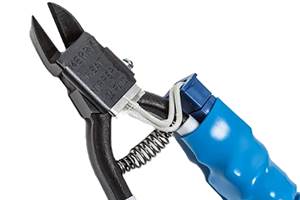‘Value-Added’ Molder Adds 3D Printing
Processor Strategies
Wisconsin molder's recent decision to bring water-transfer printing in-house makes it one of the few processors to offer this decorating technology as part of its full-service offering.
Wisconsin Plastics Inc. decided recently to bring water-transfer printing in-house, making it one of the few molders to offer this decorating technology as part of its full-service product offerings. Mike Kilgore, supervisor of prototyping for the Modern Design and Development group, one of the independent companies that comprise Wisconsin Plastics (WPI) in Green Bay, Wis., spearheaded this effort. It cost the molder about $5000 up front, a price tag that included equipment and training from TWN Industries, Inc., Princeton, Fla., an internationally known leader in water-transfer printing technology. Approximately $15,000 more was invested in setting up the infrastructure to accommodate the new service.
Also known as water immersion or hydrographic printing, water-transfer printing is a 3D decorating process where elaborate graphics like wood grain, carbon fiber, camouflage, granite, and geometrical designs are applied to a product surface. It has been used to decorate items ranging from entire all-terrain vehicles and car dashboards to small items like bike helmets or automotive trim.
The process utilizes a water-soluble film that contains the printed patterns that are applied to the part. Typically, parts are first colored in-mold. The graphic film is then trimmed and placed in a tank of heated water for 60 sec, then sprayed with a patented chemical activator. The activator liquefies the graphics and allows them to adhere to the molded part, essentially wrapping around it as it’s immersed in the water. The decorated part is then rinsed and painted with a clear topcoat to protect the graphic.
WPI already offers pad printing and hot stamping services. But Kilgore notes that these decorating processes cannot provide the type of surface effects possible with the new technology. “One key advantage with the water-transfer printing process is that you can use it on parts with complex geometries, including round and deep-walled shapes,” he says. “You can give a part a final graphic look that you wouldn’t expect to see in off-the-shelf commercial or retail items. Basically, this process is suitable anytime you want to give a product a unique look.”
In its first application of the technology, WPI took its value-added philosophy to another level by actually developing the graphics for the molded items to be decorated. The customer, a major paper product manufacturer for whom the company molds paper-towel dispensers for washrooms, wanted to offer a line of soap and skin-care dispensers with a unique, upscale look.
Kilgore is actively marketing the new service, and while the goal is to acquire more customers with large-volume needs, WPI is also considering acting as a service that other processors could utilize.
WPI’s first water-transfer tank is roughly 26 in. wide by 60 in. long by 32 in. deep. Explains Kilgore, “The tank determines the size of part you can decorate, though the depth of the water is not critical. However, we can do parts that are larger than this tank—it all depends on how you process the part. We also can get a larger tank in the future as demand grows.”
He notes that while this is a semi-automated process now, WPI is aiming to make it fully automated in the near future. WPI has already developed the fixture that holds the part in the water, and the aim is to lower the part automatically with the push of a button. An operator would still lower the film into the water and spray it with the activator.
Related Content
A Guide to Ultrasonic Welding Controls
Ultrasonic welding today is a sophisticated process that offers numerous features for precise control. Choosing from among all these options can be daunting; but this guide will help you make sense of your control features so you can approach your next welding project with the confidence of getting good results.
Read MoreNew Cleanroom-Rated Static Eliminator
Neutralize static hands-free in sensitive medical, pharmaceutical and electronic manufacturing operations.
Read MoreHeated Nippers Offer Easier Degating
Globeius is now offering heavy-duty heated nippers from MouldPro for safer, more efficient cutting of plastics and removal of gates from molded parts.
Read MoreCan Plastic Recyclates be Welded Ultrasonically?
What is possible with ultrasound? Will the result with recycled plastics material actually be worse than with standard material? Do we have to adapt our technology?
Read MoreRead Next
Processor Turns to AI to Help Keep Machines Humming
At captive processor McConkey, a new generation of artificial intelligence models, highlighted by ChatGPT, is helping it wade through the shortage of skilled labor and keep its production lines churning out good parts.
Read MoreUnderstanding Melting in Single-Screw Extruders
You can better visualize the melting process by “flipping” the observation point so that the barrel appears to be turning clockwise around a stationary screw.
Read MoreHow Polymer Melts in Single-Screw Extruders
Understanding how polymer melts in a single-screw extruder could help you optimize your screw design to eliminate defect-causing solid polymer fragments.
Read More


























